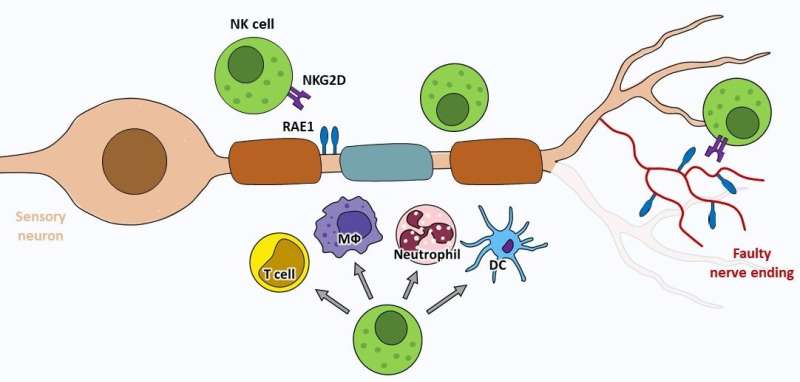This article has been reviewed according to Science X's editorial process and policies. Editors have highlighted the following attributes while ensuring the content's credibility:
fact-checked
peer-reviewed publication
trusted source
proofread
Body's immune response may offer alternative approach to neuropathic pain therapies

In the midst of a global opioid epidemic, a team of scientists is exploring natural killer (NK) cells as an alternative treatment for neuropathic pain. In an Opinion piece published June 27th in the journal Trends in Neurosciences, the researchers gather existing evidence for the impact of NK cells in pain, pointing to their ability to prune the damaged nerve cells that may cause it. They urge the scientific community to explore biological mechanisms underlying NK cell activity to move towards a realistic pain therapy that is both effective and safe.
Neuropathic pain is a chronic condition experienced as a recurring shooting or stabbing sensation. It is caused by nerve damage, which may occur because of trauma, a disease such as diabetes, or after chemotherapy.
"The prevalence of neuropathic pain is unfortunately only likely to increase over time," says co-author Alexander Davies, a neurophysiologist with the Neural Injury Group at Oxford University. "As we get better at treating diseases like cancer, we have survivors who may be left with pain from either the cancer treatment or the surgery that was used to remove it."
While therapies such as opioids and antidepressants are currently used to address these pain symptoms, they do not treat the underlying cause of pain and have their own risks and side effects. The authors point out that 564,000 people overdosed on opioids in the United States between 1999 and 2020.
"The main approach is silencing the neurons," Davies says. "While we certainly need anesthetics to deal with pain in the short term, if we use them in the long term, we can become addicted to the sensation of removing pain, which is in itself pleasurable."
Alongside T cells and B cells, NK cells are a type of white blood cell called lymphocytes. Their existing role in the body includes attacking tumors or viruses. NK cells increase activity during acute pain. However, they appear to decline in frequency or potency in people who experience chronic pain. Not having a fully functional NK cell population may therefore prevent people from resolving neuropathic pain in the long term.
"We first became interested in this idea when one of my colleagues found a T cell response after nerve injury, but I noticed that NK cells were also involved," says senior author Seog Bae Oh, a neurobiologist at Seoul National University. "NK cells are typically explored in the context of cancer, but I thought it was worth looking at them in pain as well."
NK cells may resolve pain because they are involved in the process by which neurons are pruned. Injury and disease can cause neurons to become incorrectly wired or to stop functioning as intended, resulting in pain symptoms. Introducing NK cells could help to remove these anomalies.
Experiments in mice have shown that if a neuron is in distress, its axon, the segment responsible for transmitting messages, displays a molecule called the RAE1 stress ligand. This could alert the NK cells to their need for pruning. A similar ligand, belonging to what is known as the ULBP family, is also seen in sensory neurons in humans with pain.
Conversely, NK cells may have a negative effect in the central nervous system, such as the brain and spinal cord, where neurons cannot regenerate so easily if they are removed. Their impact here should be considered carefully in the design of any possible therapies.
The authors stress that our understanding of the processes by which NK cells support pain relief is still limited, and their potential viability as a future treatment depends on further research. Both Davies and Oh are continuing to explore their NK cells in pain. Oh and his colleagues are investigating the therapeutic potential of NK cells in a range of preclinical models as well as their activity in patients who experience pain, while Davies is working to identify the cellular targets of NK cells following nerve injury.
"We need to have a better mechanistic understanding of how NK cells work and what they can target before we can develop realistic therapies, and we need to minimize their side effects," Davies says. "However, the more prongs we have to treat neuropathic pain, the more likely we are ultimately to be able to address it."
More information: Kim et al. The therapeutic potential of natural killer cells in neuropathic pain, Trends in Neurosciences (2023). DOI: 10.1016/j.tins.2023.05.008 , www.cell.com/trends/neuroscien … 0166-2236(23)00133-9




















